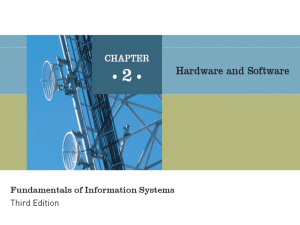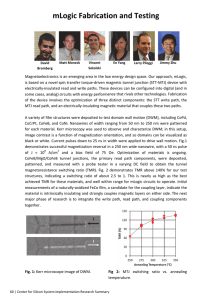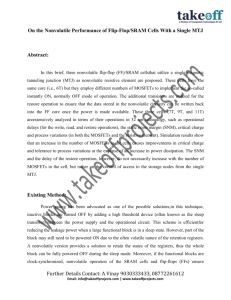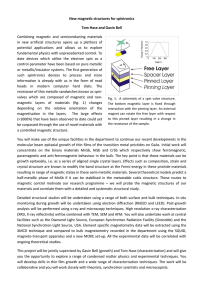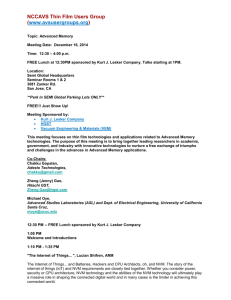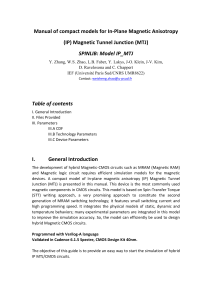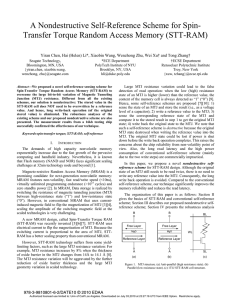WMF 2016 - WS 1.2 - Hideo Ohno Final
advertisement
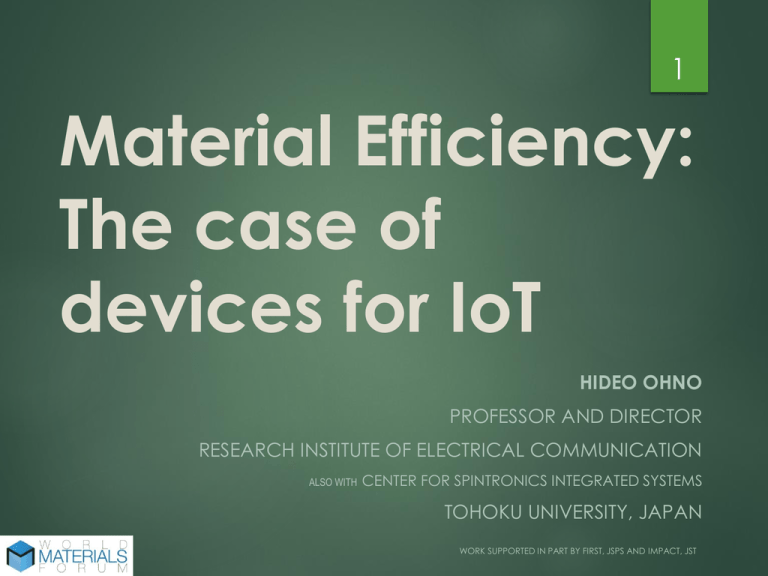
1 Material Efficiency: The case of devices for IoT HIDEO OHNO PROFESSOR AND DIRECTOR RESEARCH INSTITUTE OF ELECTRICAL COMMUNICATION ALSO WITH CENTER FOR SPINTRONICS INTEGRATED SYSTEMS TOHOKU UNIVERSITY, JAPAN WORK SUPPORTED IN PART BY FIRST, JSPS AND IMPACT, JST Market (a university professor’s view) Service $6T Industry Electronics $1.5T Semiconductor $300B 2 Market (a university professor’s view) Service $6T Industry Electronics $1.5T Semiconductor $300B 3 IoT Devices Sensors Communi cation 4 Storage Processing ► Limited bandwidth: processed data for upload ► Maintenance free: energy efficiency ► IoT devices have to be • small = material efficient • smart = information processing capability • energy efficient = low power/standby power free Spintronics does it all (Magnetic Tunnel Junction: MTJ) 5 Spintronics-based nonvolatile VLSIs (Processing and storage) Nonvolatile Memory (MTJ) Logic Spintronics devices can sense magnetic fields, generate high frequency for communication, and provides nonvolatile low-power processing They are small and can be made nonvolatile Magnetic Tunnel Junction (MTJ): key spintronics device MTJ-based magnetic sensors Courtesy of Yasuo Ando 6 MTJ based field sensor vs. MI sensors MTJ based magnetic field sensor FeCoSiB wire versus Diameter: ~20 mm Taken from http://www.aichi-mi.com/mitechnology/%E5%8E%9F%E7%90%86/ (Japanese) Size: ~mm2 7 High Frequency Generation and detection by Magnetic Tunnel Junction 8 Taken from S. Tamaru et al., J. Appl. Phys. 115, 17C740 (2014). Crystal oscillator Size: ~ mm https://en.wikipedia.org/wiki/Crystal_oscillator MTJ/CMOS Nonvolatile VLSIs 9 2013 Symposium. On VLSI Circuits 2013 IEICE Electronics Express 2012 Symposium. On VLSI Circuits 2014 IEEE ISSCC NV-TCAM NV-FPGA STT-MRAM NV-MPU Non-volatile VLSIs for search engine for big data Non-volatile field programmable gate array (FPGA) Non-volatile cash memory embedded in high speed CPU Non-volatile microcontroller for battery-driven sensor device 0.01 CMOS-based Spintronics 1 (delay) x 1 x 100 (power) 1 ≦ 1 64 (area) ※in case of used for full text search system 4.79mm 0.98mm 1 -97% 0.03 CMOS-based Spintronics 1 (delay) x 1 x 32 (power) 1 1 ≦ 2 64 (area) ※ in case of implementation to a typical application 4.79mm 1.44mm Power Consumption -99% Power Consumption Power Consumption 3.1mm 1 2.05mm 3.39mm 1 -97% 0.03 CMOS-based Spintronics 1 1 1 1 x x ≦ 1.5 29 1.7 64 (delay) (power) (area) ※in case of typical cash operation Power Consumption 3.5mm 1 -98% 0.02 CMOS-based Spintronics 1 (delay) x 1 x 80 (power) 1 ≦ (area) 1 64 ※in case of use in a wireless sensor device Battery-free: Can we get there? 10 ▌Energy Harvesting 300 mW: Solar cell with room light 100 mW: Vibration 200 mW ▌Intermittent Sensing 電池寿命 80日 ▌Distribution of Power 200 mW • Sensing: • RF: • Microcontroller: 20 μW 80 μW 100 μW Power (mW) 10×10 sec-sensing a day ハーベスティング で 動作可能な消費電 力 1/3 1/100 永年駆動 Without spin (today) Without spin (5yrs later) With spin (5yrs later) High performance nonvolatile memory element: 11 Perpendicular MgO-CoFeB MTJ Interface! S. Ikeda et al., Nature Mat. 9, 721 (2010) Magnetic Tunnel Junction - bulk versus interface FePt (bulk) 12 CoFeB (interface) Materials Efficiency (Cost of material) 10 :1 13 Recycling at the level of manufacturing tool: efficiency MTJ Material Target 300 mm wafer ~3% 97% left in the chamber http://www.tel.co.jp/news/2014/1201_001.htm MTJ Product SUMMARY 14 Spintronics device (Magnetic Tunnel Junction) provides key functionalities required for IoT: sensing, communication, and information processing/storage It is material efficient and becoming more so with newly developed device structure (interface) Retrieving unused materials from manufacturing tools under development for further increasing the material efficiency Next: Wireless Passive Sensor Technology, Donald C. Malocha
